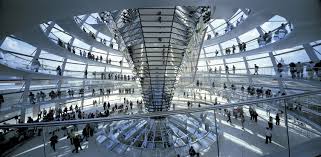
When discussing modern architecture, one name often stands out: Norman Foster, a pioneer of High-Tech architecture. Known for his innovative designs that blend technology, sustainability, and aesthetics, Foster has transformed skylines worldwide. His work emphasizes functionality and efficiency, while also celebrating the beauty of engineering.
Who Is Norman Foster?
Born on June 1, 1935, in Manchester, England, Norman Foster grew up in humble surroundings. His passion for architecture led him to study at the University of Manchester School of Architecture and later at Yale University, where he was deeply influenced by modernist architects like Frank Lloyd Wright and Ludwig Mies van der Rohe.
In 1967, he founded Foster + Partners, a firm that would go on to redefine architecture with its cutting-edge designs. Today, Foster’s projects are recognized for their futuristic approach and their seamless integration of technology and design.
What Is High-Tech Architecture?
High-Tech architecture, also known as Structural Expressionism, emerged in the late 20th century. It’s characterized by:
- Exposed Structural Elements: Steel frames, glass façades, and visible mechanical systems.
- Innovative Use of Materials: Lightweight and durable materials like aluminum, steel, and glass.
- Technological Integration: Emphasis on incorporating advanced engineering and sustainable technologies.
- Transparency and Flexibility: Open floor plans and extensive use of natural light.
Foster’s designs are a perfect embodiment of these principles, merging form and function into spectacular architectural achievements.
Iconic Works of Norman Foster
| Structure | Location | Year Completed | Notable Features |
|---|---|---|---|
| The Gherkin (30 St Mary Axe) | London, UK | 2004 | Distinctive glass-and-steel structure; energy-efficient design. |
| Hong Kong and Shanghai Bank HQ | Hong Kong | 1985 | Exposed structural elements; flexible, modular office spaces. |
| Millau Viaduct | Millau, France | 2004 | World’s tallest bridge; sleek, minimalist design. |
| Reichstag Dome | Berlin, Germany | 1999 | Transparent dome symbolizing political transparency; utilizes renewable energy. |
| Apple Park Headquarters | Cupertino, California, USA | 2017 | Circular, futuristic design with a focus on sustainability. |
Fun Fact
Norman Foster’s nickname, “The Lord of Steel and Glass,” reflects his mastery of using these materials to create strikingly modern and functional buildings.
Sustainability in Foster’s Designs
One of the most remarkable aspects of Foster’s architecture is his commitment to sustainability. His buildings often include features like:
- Solar Panels and Wind Turbines: For renewable energy generation.
- Natural Ventilation Systems: Reducing reliance on artificial cooling and heating.
- Green Roofs and Rainwater Harvesting: Promoting ecological balance and water conservation.
- Daylighting Strategies: Maximizing natural light to reduce energy consumption.
The Reichstag Dome, for instance, is equipped with a mirrored cone that reflects sunlight into the building, significantly reducing energy costs.
Comparison Table: Norman Foster vs. Traditional Modernist Architecture
| Aspect | Traditional Modernism | Norman Foster’s High-Tech Architecture |
|---|---|---|
| Materials | Concrete, steel, glass | Advanced materials like aluminum and composites |
| Focus | Minimalism and simplicity | Technological innovation and functional transparency |
| Sustainability | Rarely a focus | Core element of design |
| Aesthetic Approach | Purely visual appeal | Integration of beauty with engineering and efficiency |
FAQs About Norman Foster
1. What is Norman Foster’s most famous work?
Foster’s 30 St Mary Axe (The Gherkin) in London is one of his most iconic designs, celebrated for its futuristic appearance and sustainable features.
2. What awards has Norman Foster received?
Norman Foster has received numerous accolades, including the Pritzker Architecture Prize in 1999, often regarded as the Nobel Prize of architecture.
3. How does Foster integrate technology into his designs?
Foster uses advanced engineering techniques, renewable energy systems, and cutting-edge materials to create buildings that are both functional and visually stunning.
4. Is sustainability a core principle of Foster’s architecture?
Yes, sustainability is central to Foster’s designs, evident in projects like the Reichstag Dome and Apple Park Headquarters.
Fun Fact
Norman Foster holds the title of Baron Foster of Thames Bank, granted to him in 1999, making him a life peer in the United Kingdom.
The Philosophy Behind Foster’s Designs
Foster once said, “As an architect, you design for the present with an awareness of the past, for a future which is essentially unknown.” This philosophy underscores his commitment to creating timeless structures that serve both functional and environmental needs.
His designs don’t just look futuristic—they’re designed to last for generations, adapting to evolving technological and societal needs.
Legacy of Norman Foster
Norman Foster’s influence on architecture is immense. His works have redefined urban landscapes, showcasing how technology and design can work together to create spaces that are as functional as they are beautiful.
Whether it’s the soaring elegance of the Millau Viaduct or the political symbolism of the Reichstag Dome, Foster’s designs continue to inspire architects and engineers alike.
If you’re a fan of futuristic architecture, a visit to one of his iconic buildings is a must. As Foster’s work reminds us, architecture is not just about shelter—it’s about creating spaces that inspire, connect, and endure.





Leave a Reply